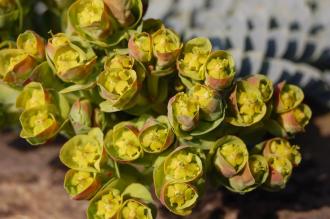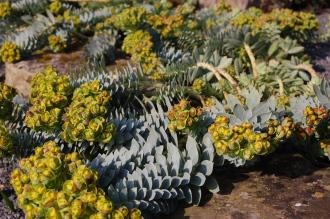
Euphorbia myrsinites Flower (11/03/22012, Kew, London)
Position: Full sun
Flowering period: Spring
Soil: Moist, well drained
Eventual Height: 10cm
Eventual Spread: 50cm
Hardiness: 5a – 9a
Family: Euphorbiaceae
Euphorbia myrsinites is a mat forming, evergreen succulent perennial. Its fleshy grey/ blue leaves are pointed, spirally arranged arround the stems and are up to 2cm long. The prostrate fleshy stems of the plant are sprawling and up to 40cm long. The flowers, borne at the ends of the stems, are inconspicuous, surrounded by bright sulfur yellow, cup shaped bracts.
Euphorbia myrsinites, commonly known as Myrtle Spurge, Donkey Tail or Creeping Spurge, is native to southeastern Europe and northern Turkey. This plant considered an invasive weed in a number of locations through out the world, including parts of the USA. The milky sap may cause eye and skin irritation in some individuals.
The etymological root of the binomial name Euphorbia is derived from the name of Euphorbus physician to Juba, King of Mauritania. Myrsinities is derived from the Greek mursinh ’Myrtle’ or ‘Myrtus communis‘, in reference to the plants Myrtle like leaves (in shape).

Euphorbia myrsinites (11/03/22012, Kew, London)
The landscape architect may find Euphorbia myrsinites useful as a low ground cover evergreen perennial, particularly in dry locations. This plant is drought tolerant once established and is suitable for xeriscaping.
Ecologically, E. myrsinites is attractive to pollinating insects.
The Royal Horticultural Society has given E. myrsinites their prestigious Award of Garden Merit in 1993.
E. myrsinites prefers moist, well-drained soils. It tolerates most pH of soil.
E. myrsinites requires little maintenance.

